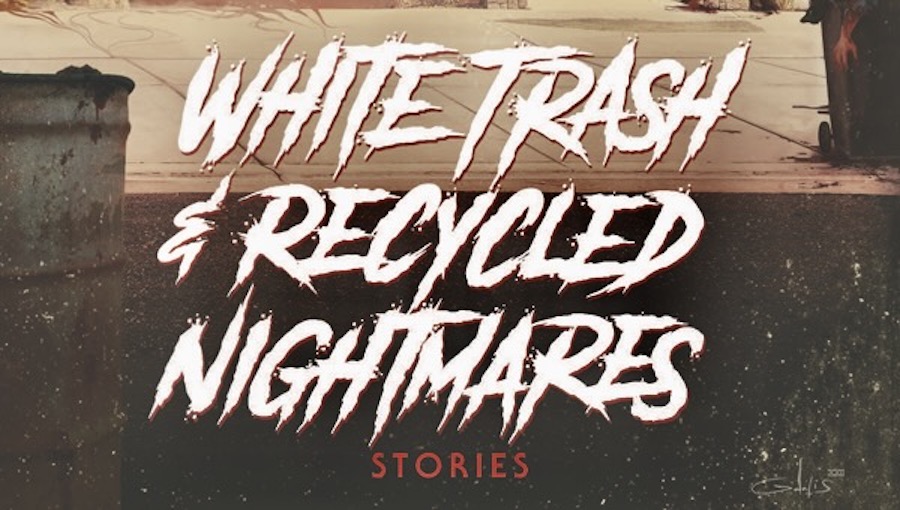The following is an interview with Rebecca Rowland regarding the upcoming release of the horror anthology, White Trash and Recycled Nightmares, with Dead Sky Publishing. In this interview, Fanbase Press Editor-in-Chief Barbra Dillon chats with Rowland about the creative process of bringing the collection of stories to life, how the stories may connect with readers, and more!
Barbra Dillon, Fanbase Press Editor-in-Chief: Congratulations on the upcoming release of White Trash and Recycled Nightmares! How would you describe your thematic approach when crafting this collection of stories?
Rebecca Rowland: About 80% of the collection was previously published in thematic anthologies or magazines; that’s one of the major differences between WT&RN and my previous collection, The Horrors Hiding in Plain Sight. All of the stories in the latter were new to the collection. When putting this book together, I didn’t select stories based on a tight theme. Rather, like one of my favorite short fiction collections, Stephen Graham Jones’ After the People Lights Have Gone Off, the stories explore everyday fears in unusual ways. WT&RN was originally conceived as a group of tales I’d written during a period in my life when I suffered from severe insomnia; the little sleep I did get was plagued with vivid dreams, many of them bizarre or frightening. I started writing down what I remembered of the dreams when I awoke, and weeks, sometimes months later, I’d grab one of the snippets and shape it into a story. Because of that inception, there is definitely a unified mood of anxiety, perhaps even paranoia, throughout.
BD: As a writer, do you find that there are more similarities or differences to your creative approach to writing horror and dark fiction?
RR: About a quarter of my fiction work over the past decade has been in curating anthologies. Although there is certainly a difference between editing and writing, I try to employ similar skills and approaches. When I am sorting through submissions for an anthology, I am drawn first to stories that are written well–the plotline is actually secondary. As a writer, I’m most concerned with how something reads than what it says. I have to be able to hear the sentences in my head, which is likely why the cadence of others’ writing is in the forefront of my mind when I am reading and editing. On the same note, I approach editing from a writer’s point-of-view. I try to put myself in an author’s shoes when I am making suggestions. I can always tell when I am working with an editor who isn’t a writer first: s/he approaches the work with a managerial eye instead of a creative one. Yes, it’s absolutely important to have all of the t’s crossed and i’s dotted, but the music of the work, the art, is much more about instinct and emotional resonance.
BD: Do you feel that this collection complements your previous work on The Horrors Hiding in Plain Sight, and what are you most excited for readers to experience with these stories?
RR: Horrors is specifically a collection of quiet, psychological horror without speculative elements. People who regularly read my work know that most of what I write is concerned with the monstrosity within everyday people—in my opinion, human beings are a thousand times more frightening than any vampire, werewolf, or zombie. However, White Trash & Recycled Nightmares is a much broader array of subgenres than Horrors: in addition to those quiet pieces, this collection contains tales of supernatural creatures: ghouls, sirens, werecats, and wendigos. The common thread is still the unnerving nature of one’s partner, child, or neighbor, but I’ve doubled down on the terror. I think readers will be pleasantly surprised.
BD: What makes Dead Sky Publishing the perfect home for this anthology?
RR: Over the past few years, Dead Sky has structured their catalog to incorporate an eclectic range of work, from weird westerns and splattergore to contemporary Southern gothic and environmental horror. I like to think WT&RN is a perfect fit in that cornucopia of horror subgenres, as readers will get a little bit of every type of horror in this collection, from cosmic and creature feature to paranormal and feminist.
BD: Are there any upcoming projects on which you are currently working that you would like to share with our readers?
RR: Michael Aloisi and I penned Pieces and The View Master together; we now have a short collection of fiction releasing in January titled What Hath Women Rot. 100% of the proceeds benefit Children of the Night, an organization that helps survivors of human trafficking, and it will appear exclusively on the Godless platform first.
BD: Lastly, what is the best way for our readers to find more information about White Trash and Recycled Nightmares and your other work?
RR: I maintain a pretty pedestrian website (RowlandBooks.com), but I’m also on Instagram, @Rebecca_Rowland_books. I’ll be at conventions all around the country in the next twelve months with copies of WT&RN, as well as my most recent anthology, American Cannibal, so I hope if people are in the neighborhood, they will stop by and say hello!

